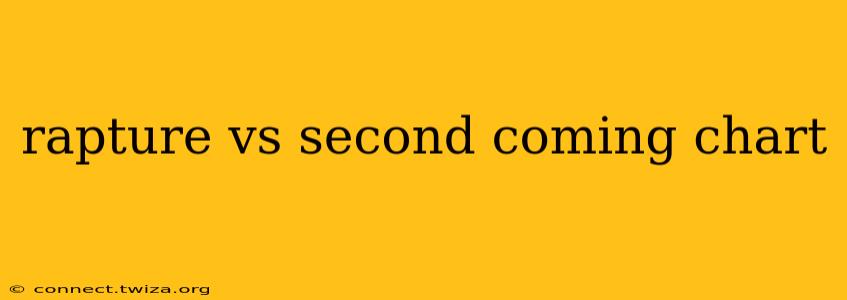Rapture vs. Second Coming: A Comparative Chart and Explanation
The terms "Rapture" and "Second Coming" are often used interchangeably, especially within Christian circles, but they represent distinct theological concepts with significant differences. Understanding these distinctions is crucial for a clear comprehension of end-times prophecies. This article will clarify the differences between these two events through a comparative chart and detailed explanations, addressing common questions and misconceptions.
Rapture vs. Second Coming: A Comparison Chart
| Feature | Rapture | Second Coming |
|---|---|---|
| Timing | Before the Tribulation Period (Pre-Trib) or during (Mid-Trib) or after (Post-Trib) | After the Tribulation Period |
| Who's Involved | Believing Christians only | All people, both living and dead |
| Method | Supernatural, instantaneous translation | Visible, glorious arrival |
| Location | Heaven | Earth |
| Purpose | Removal of believers from God's wrath | Final judgment, establishment of God's kingdom |
| Biblical Basis | 1 Thessalonians 4:13-18; Revelation 3:10 | Matthew 24:29-31; Revelation 19:11-21 |
| Events Preceding | Vary depending on pre-, mid-, or post-tribulation view. | The Tribulation Period, Great Tribulation |
| Events Following | Varies widely depending on theological interpretation | Millennium, Final Judgment, New Heaven and New Earth |
Detailed Explanations and FAQs
What is the Rapture?
The Rapture, a belief held primarily by certain evangelical Christian denominations, describes a pre-Tribulation (before the tribulation period), mid-Tribulation, or post-Tribulation (after the tribulation period) event where believing Christians are snatched up to meet Christ in the air. This event is believed to be sudden, invisible to non-believers, and marks the beginning or a key point within the end times. The exact timing of the rapture is a point of much debate among theologians.
What is the Second Coming?
The Second Coming, also known as the Parousia, is the visible, glorious return of Jesus Christ to Earth. This event is universally accepted within Christianity as a future occurrence, marking the culmination of history and the establishment of God's kingdom. It will be a public event witnessed by all people.
What is the Tribulation Period?
The Tribulation Period, a 7-year period of great upheaval and suffering described in the Book of Revelation, is a central element in many end-times interpretations. Different views on the Rapture's timing place it before, during, or after this period, significantly influencing the understanding of both events.
Does the Bible explicitly mention the Rapture?
The Bible does not explicitly use the word "Rapture," a term coined in the 19th century. However, proponents point to passages like 1 Thessalonians 4:13-18 as describing a catching away of believers to meet Christ in the air, interpreting this as the rapture. This passage is the most common proof-text for the rapture, but its meaning is disputed among theologians.
Are the Rapture and the Second Coming the same event?
No, while closely related in the context of end-times prophecy, they are distinct events. The Rapture is typically viewed as a secret, pre-Tribulation, mid-Tribulation, or post-Tribulation event involving only believers, while the Second Coming is a public, post-Tribulation event involving all humanity.
What happens after the Rapture?
The events following the Rapture depend heavily on the specific theological viewpoint. Pre-Tribulation Rapture proponents believe it will be followed by the Tribulation Period, while Post-Tribulationists see it as happening after the Tribulation. Mid-Tribulation views place it midway, creating a unique set of sequential events.
What happens after the Second Coming?
The Second Coming is followed by the Millennium, a thousand-year reign of Christ on Earth, the final judgment, and the establishment of the New Heaven and New Earth.
This detailed explanation, combined with the chart, should provide a clearer understanding of the differences between the Rapture and the Second Coming. It is important to remember that interpreting end-times prophecies remains a complex theological endeavor, and different Christian denominations and individuals hold varying interpretations. Further research and study from reputable theological sources are encouraged for a more comprehensive understanding.
